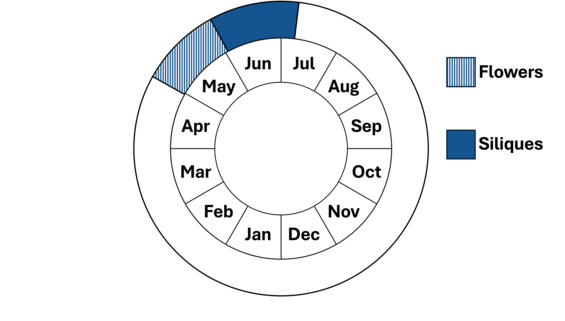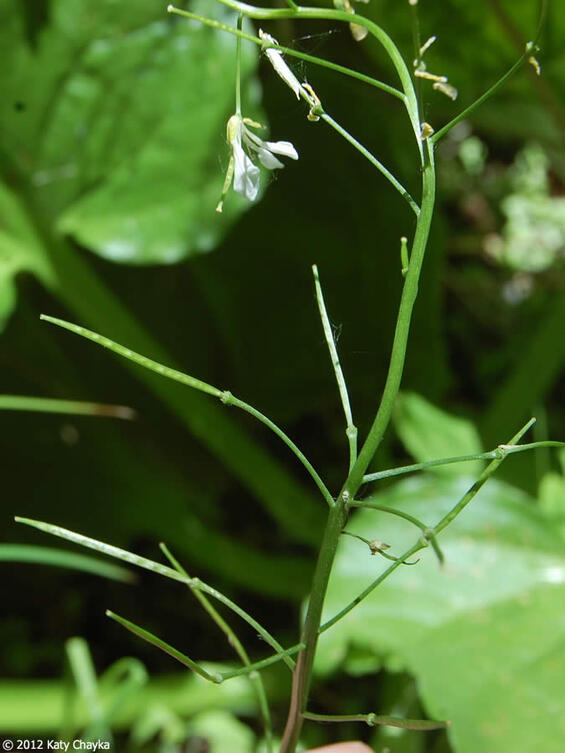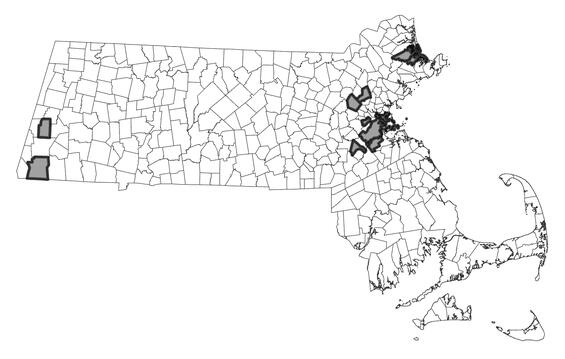- Scientific name: Cardamine bulbosa (Schreb. Ex Muhl.) Britton, Sterns & Poggenb.
- Species of Greatest Conservation Need (MA State Wildlife Action Plan)
Description

Cardamine bulbosa in bloom. Photograph by Peter Dziuk, MinnesotaWildflowers.info
Spring cress (Cardamine bulbosa) is a perennial herb of the mustard family (Brassicaceae). It is a spring ephemeral found in floodplains and in low wet woods across Massachusetts. It produces single stems which are rarely branched, reaching heights of 15-50 cm. (6 -20 in). The stems are typically glabrous (having no hairs) though they may occasionally have hairs pressed flat against the stem. It has whorl of basal leaves with long petioles (leaf stems) and has 4 to 14 alternate stem leaves. The stem leaves are ovate, rounded to lanceolate; the lower leaves have petioles while the upper leaves are sessile (attach directly to the stem), and may be slightly toothed. The flowers are in a terminal raceme. the sepals are green with white edges, while 4 petals are all white, 7-16 mm (0.25-0.6 in) long. The fruits are linear upright siliques 2-4 cm (0.75-1.5 in) long, which retain the conspicuous stigma at the tip. The lower siliques are on pedicels (flowering and fruiting stems) 1.5-2.5 cm (0.6-1 in) long.
Spring cress is sometimes confused with purple cress (C. douglassii), as both are similar in size and have terminal flowers. However, purple cress usually has a hirsute (pubescent with spreading hairs) stem, especially just below the flowers, its sepals are purple tinged, and the petals are rose-purple or purple tinged too, though there is a white form. The linear siliques are similar to those of spring cress, with the lowest ones on pedicels 1.5-4 cm (0.6-1.5 in) long. Purple cress typically blooms 3 to 4 weeks before spring cress, however, hybrids of the two species are known.

Cardamine bulbosa full plant with flowers and leaves. Photograph by Katy Chayka, MinnesotaWildflowers.info
Life cycle and behavior

In early spring, spring cress grows from a rhizome and will bloom from the second week of May through the beginning of June. Its white flowers are pollinated by early flying butterflies. Siliques ripen near the end of June into early July.

Cardamine bulbosa siliques. Photograph by Katy Chayka, MinnesotaWildflowers.info
Population status
Spring cress is listed as a species of greatest conservation need and is maintained on the Massachusetts plant watch-list. There are nineteen populations confirmed since 1999 found in Berkshire, Essex, Middlesex, Norfolk, and Suffolk counties. Historically, spring cress has also been found in Hampshire County.
Distribution and abundance
Spring cress is known from across eastern North America from Quebec to Manitoba south to Florida and Texas. In New England, it is possibly extirpated from New Hampshire, critically imperiled in Maine and Vermont, imperiled in Massachusetts, apparently secure in Connecticut and has not been observed in Rhode Island.

Distribution in Massachusetts
1999-2024
Based on records in the Natural Heritage Database
Habitat
Spring cress occurs in wetland forests, shores of rivers or lakes, swamps, and wetland edges.
Healthy habitats are vital for supporting native wildlife and plants. Explore habitats and learn about conservation and restoration in Massachusetts.
Threats
The primary threat to spring cress is destruction of habitat. Although it is usually found in areas protected by the Massachusetts Wetlands Protection Act, it blooms early in the spring and its presence may not be known. Some of the wetland areas where it grows are ephemeral and dry in the summer. Secondary threats include a lack of disturbance, shading by dense forest canopy and competition with invasive species. When it occurs in wet meadows, they may be mown before the seeds have ripened.
Conservation
Survey and monitoring
Updated surveys for this species are needed to determine if populations still occur near the previously known locations. De novo surveys in new locations will help determine if the species is decreasing. Each stem is considered a separate genet. The best time to survey for spring cress is when it is in bloom, early May to early June.
Management
The exact ecological needs of spring cress are not known. If populations are observed to be decreasing, it is important to determine the cause and actions needed. All active management of rare plant populations (including invasive species removal) is subject to review under the Massachusetts Endangered Species Act and should be planned in close consultation with the MassWildlife’s Natural Heritage & Endangered Species Program.
Research needs
As this plant is under-surveyed, more standard information is needed such as lists of associated species, comments on habitat quality and threats, and assessments of soil conditions and phenology. Research is needed to determine whether this plant can be grown in a nursery or garden setting for purposes of reintroductions. If habitat degradation accelerates losses of current populations, this strategy could prove useful to long-term conservation of this species.
References
Fernald, M. L. 1950. Gray’s Manual of Botany, Eighth (Centennial) Edition—Illustrated. American Book Company, New York.
Haines, A. 2011. Flora Novae Angliae – a Manual for the Identification of Native and Naturalized Higher Vascular Plants of New England. New England Wildflower Society, Yale Univ. Press, New Haven, CT.
Native Plant Trust. 2014. NORM Phenology Information.
NatureServe. 2025. NatureServe Network Biodiversity Location Data accessed through NatureServe Explorer [web application]. NatureServe, Arlington, Virginia. Available https://explorer.natureserve.org/. Accessed: 3/26/2025.
POWO (2025). Plants of the World Online. Facilitated by the Royal Botanic Gardens, Kew. Published on the Internet; https://powo.science.kew.org/ Accessed: 3/26/2025.
Contact
| Date published: | April 8, 2025 |
|---|